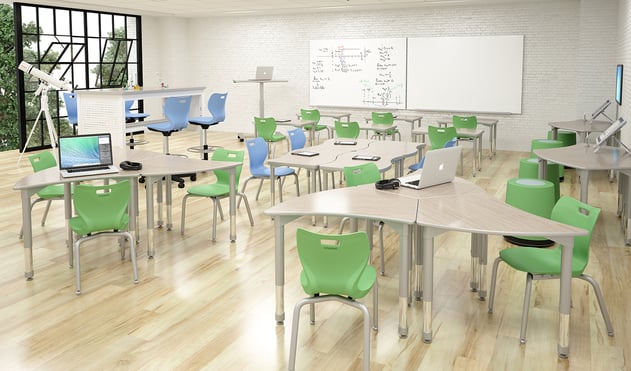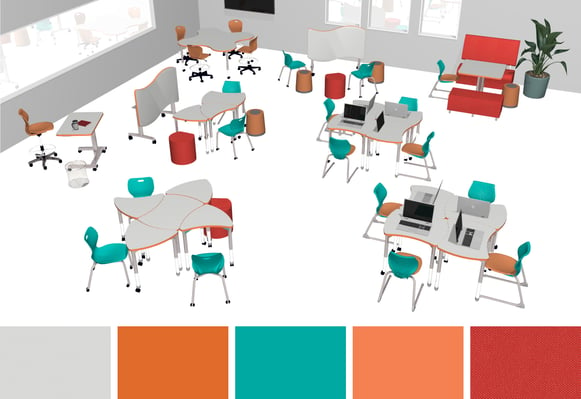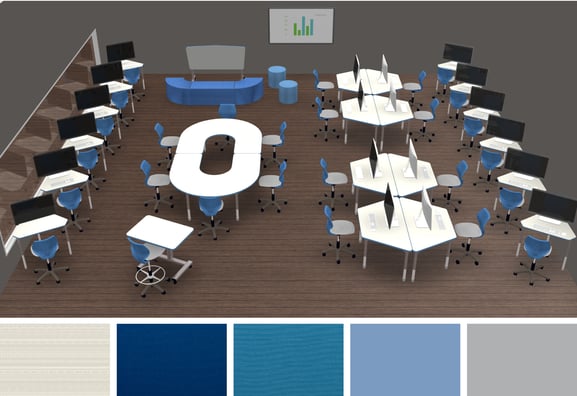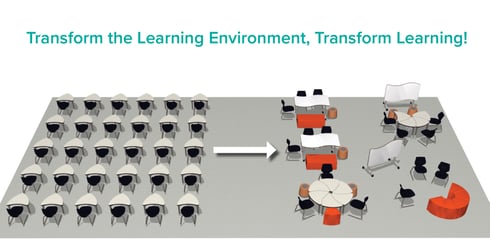This blog is part of our Design Matters series:
- How to Design Classrooms that Transform Learning
- Creating a Welcoming Classroom Environment
- Strategically Planning Classroom Flow
- Develop a Critical Eye for How Learning Spaces Support Learning
As you strive to transform learning at your school, you’ve likely taken a closer look at transforming your learning environments. Critical to this is understanding the design of your space! Research shows that classroom design has an immediate and lasting effect on students’ physical, psychological, physiological, and cognitive abilities.
Research also points out that color, comfort, space, movement, and flexibility of classroom furniture are all things to consider because it impacts student achievement. (2017, Sheninger and Murray)
In this blog, we’ll discuss what you should consider when planning for today and preparing for tomorrow’s learning spaces, especially in regard to school furniture and classroom design.
Related Article: Use Classroom Arrangement to Promote Students’ Cognitive Development

Must-Know Tips for Creating a Transformed Learning Environment
Transforming your learning environment can be overwhelming without the right guidance! While this list doesn’t cover everything you should know about classroom design, these must-know tips will get you started in the right direction.
- Shift your mindset: As you transform your learning environment, you’ll need to shift your mindset and move past desks and chairs in order to focus on using flexible work surfaces and seating. When you allow students and teachers to design their classrooms using flexible furniture based on specific learning objectives, it increases their engagement and promotes ownership.
- Evaluate your resources and materials: You may have run into the question, “What supplies and furniture are really needed for student success?” This is a great concern! Can you ever have too much stuff? Yes! Calculate your school’s storage needs and organize all of your learning materials. Encourage teachers and administrators to take the time to declutter classrooms and other learning spaces across your school. Busy rooms with “too much” stuff can overstimulate students and disrupt their ability to concentrate.
- Let them move: Movement! Sitting, standing, bouncing, wiggling, and shifting are all activities that increase blood flow and respiration, which ignites the brain and gives students the opportunity to process and retain the information they’re learning.

- See color: Did you know that color is scientifically proven to influence our mood, perception, and behavior? Professionals in the design industry will tell you the importance of color and how it comes into play when designing spaces. Evaluate the use of colors across your learning environments, especially your school’s specific colors (branding). It’s important to encourage and promote school spirit by creating a sense of community. Strategically place your school’s colors in collaborative spaces like media centers, cafés, or multipurpose rooms. For classrooms, use colors that meet the needs and objectives of each particular space.
For example, consider using bright colors in maker spaces, art rooms, robotic labs, and other learning environments that should promote creativity and innovation.
Consider using cool colors in learning spaces where students need to concentrate, focus, or relax.
- Plan for open space: Crowded environments can increase anxiety and overwhelm the inhabitants. You should carefully evaluate spaces for their purpose and add furnishings to support each individual space. Do you need 30 chairs with 30 desks? Or, can you rethink the learning space using flexible furniture instead?
For example, in the situation described above, you could furnish your learning space with flexible seating using 16 NXT MOV® chairs, 6 MOV stools, 6 soft seating ottomans, 2 benches (seats 2), and configurable work surfaces using 4 nesting tables, and 10 configurable desks.
Related Article: What’s Flexible Seating & Why is it Crucial in Classrooms?
Using the Power of Classroom Design to Transform Learning
The possibilities are endless when evaluating and planning out learning spaces that promote student success. If you’re ready to take the next step in designing a learning environment that transforms learning, take advantage of our free workbook, “Rethinking Classroom Learning Environments for the Future.”
--
- Sheninger, Eric, and Murry, Thomas. “Designing Learner-Centered Spaces”, THE Journal, July 2017, https://thejournal.com/articles/2017/07/05/designing-learner-centered-spaces.aspx. Accessed 9 Aug. 2019.
- Regina Bailey. “Color Psychology: How Colors Affect Human Behavior.” ThoughtCo, 6 May 2019, www.thoughtco.com/color-psychology-and-human-behavior-4151666. Accessed 26 Apr. 2021.
